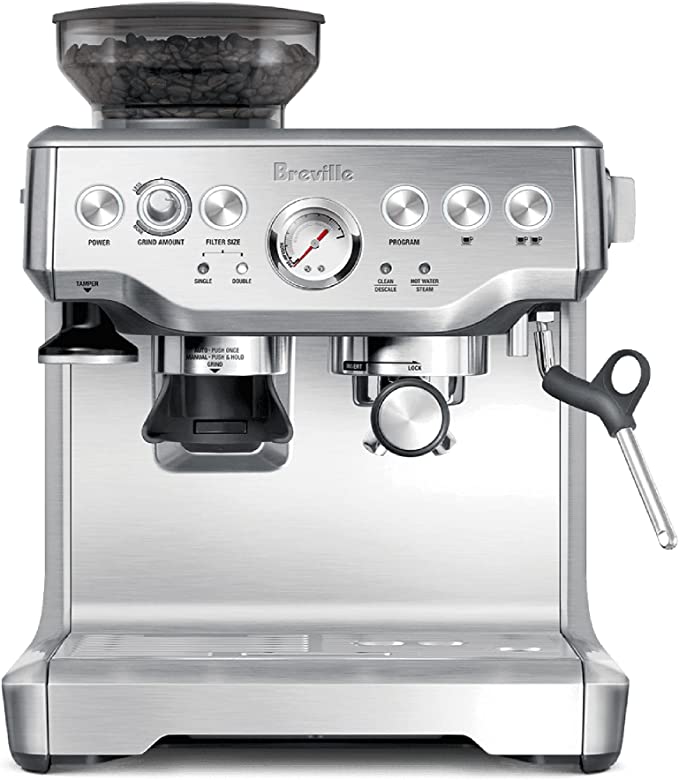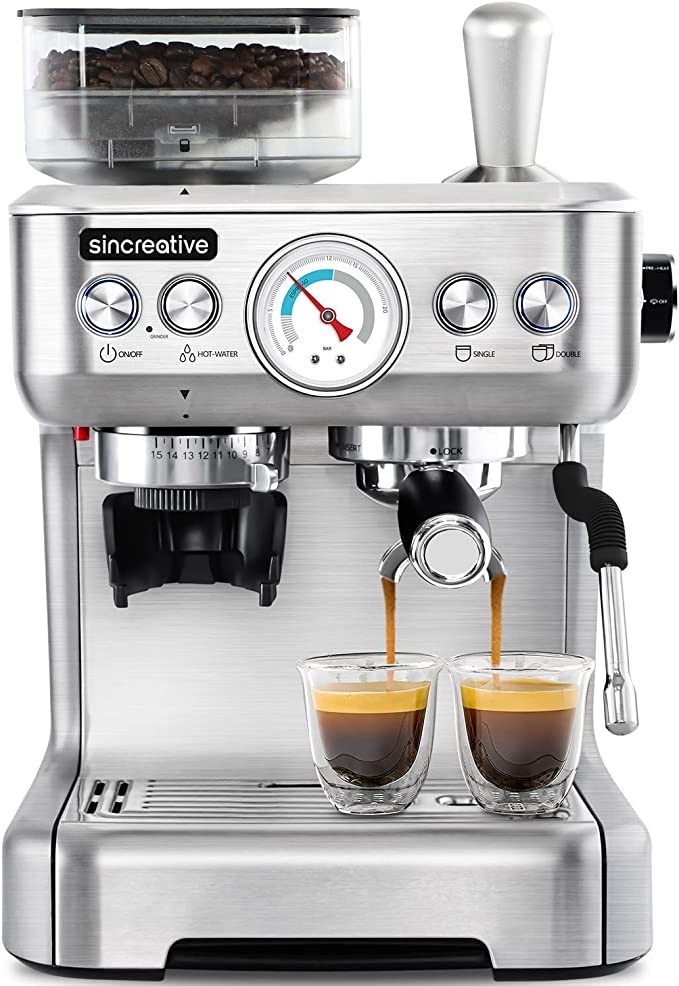Gaggia Classic Evo Pro: Mastering Espresso Science at Home
Update on Feb. 7, 2025, 8:21 a.m.
That first sip. The rich aroma, the velvety crema, the complex dance of flavors – a perfect espresso is a sensory experience unlike any other. But achieving that perfection at home often feels elusive. You’ve tried different beans, adjusted your grind, yet the results remain inconsistent. What’s the secret? The answer, surprisingly, lies in understanding the science.
Before we delve into the inner workings of a machine that brings this science to your countertop, let’s take a brief journey back to where it all began. In 1938, Milanese café owner Achille Gaggia revolutionized espresso brewing. He invented a lever-operated system that, for the first time, used water pressure instead of steam to extract coffee. This innovation not only eliminated the burnt taste often associated with steam-driven machines but also produced the signature crema – that golden layer of emulsified oils – that defines true espresso. Gaggia’s invention laid the foundation for the modern espresso machine, and the brand that bears his name continues to uphold this legacy of innovation.
So, what is the science behind that perfect shot? It boils down to three critical factors: pressure, temperature, and grind.

Pressure Perfected: The 9-Bar Rule
Imagine trying to squeeze juice from an orange. Apply too little pressure, and you’ll get a meager trickle. Apply too much, and you risk bursting the orange and extracting unwanted bitterness. Espresso extraction is remarkably similar. The ideal pressure, widely accepted within the specialty coffee community, is 9 bars – approximately nine times the atmospheric pressure at sea level.
Why 9 bars? This pressure is the sweet spot for extracting the desirable compounds from finely-ground coffee: the aromatic oils, the flavorful acids, and the rich, caramelized sugars. Lower pressure results in under-extraction. The water flows through the coffee grounds too quickly, failing to dissolve these essential components. The resulting espresso is weak, sour, and lacks body. Conversely, excessive pressure leads to over-extraction. The water forces its way through, extracting undesirable bitter compounds and creating a harsh, unpleasant taste.
The Gaggia Classic Evo Pro is meticulously engineered to deliver consistent 9-bar pressure. This is achieved through an updated Over Pressure Valve (OPV), a crucial component that regulates the water pressure entering the brewing system.

Temperature’s Tango: The Importance of Stability
Just as crucial as pressure is temperature. The ideal water temperature for espresso brewing lies between 195°F and 205°F (90°C - 96°C). This narrow range ensures optimal extraction without scorching the coffee. Fluctuations in temperature can lead to inconsistent results, with even a few degrees making a noticeable difference in the final cup. This is where the material choice in the Gaggia Classic Evo Pro becomes critical. The machine features a boiler and group head made of brass. Brass, an alloy of copper and zinc, is renowned for its excellent thermal conductivity and thermal mass. This means it heats up quickly and, more importantly, retains heat effectively. This thermal stability ensures that the water temperature remains within the optimal range throughout the brewing process, contributing to a consistently delicious extraction.
The Grind: A Microscopic View
The final piece of the espresso puzzle is the grind size. Think of coffee beans as tiny treasure chests filled with flavor. The grind size determines how easily we can access that treasure. Too coarse, and the water rushes through, barely interacting with the coffee particles – under-extraction again. Too fine, and the water struggles to pass through, creating excessive pressure and over-extraction.
The ideal grind for espresso is very fine, almost like powdered sugar, but with a slight grittiness. This fine grind creates a large surface area for the water to interact with, allowing for the optimal extraction of those desirable flavor compounds. The Gaggia Classic Evo Pro doesn’t include a built-in grinder (a crucial point to note – a quality burr grinder is essential for espresso), but its design anticipates and complements the use of a high-quality external grinder.
Inside the Gaggia Classic Evo Pro: Commercial-Grade Features at Home
The Gaggia Classic Evo Pro isn’t just about understanding the science; it’s about putting that science into practice. It does this by incorporating features typically found in professional, commercial-grade machines:
The 58mm Portafilter: More Than Just Size
The portafilter is the handle-like device that holds the coffee grounds during brewing. The Gaggia Classic Evo Pro boasts a 58mm portafilter, the standard size used in commercial espresso machines. This isn’t just about looking professional; it has practical benefits. The larger diameter allows for a wider, shallower coffee puck. This wider puck promotes more even water distribution throughout the grounds, leading to a more uniform extraction. Furthermore, the portafilter is made of polished steel. Steel, like brass, possesses excellent thermal properties, helping to maintain a stable temperature during brewing.

The Three-Way Solenoid Valve: The Unsung Hero
This often-overlooked component plays a crucial role in the espresso-making process. After you finish brewing, the three-way solenoid valve instantly releases the pressure within the brewing system. This does two important things: First, it stops the extraction immediately, preventing over-extraction and dripping. Second, it creates a vacuum that sucks the excess water out of the coffee puck, leaving it relatively dry and easy to knock out of the portafilter. This makes cleanup easier and keeps your machine cleaner. Imagine the difference between trying to remove a soggy, dripping tea bag versus a relatively dry one – that’s the impact of the three-way solenoid valve.
The Commercial Steam Wand: Mastering Microfoam
Espresso is only part of the equation for many coffee lovers. The Gaggia Classic Evo Pro features a commercial-style steam wand, allowing you to create lattes, cappuccinos, and other milk-based beverages. The “commercial” designation isn’t just marketing; it signifies a design that provides greater control and power compared to many home espresso machines.
Creating perfect microfoam – that velvety, smooth texture that blends seamlessly with espresso – is a bit of an art, but also a science. The steam wand injects air into the cold milk while simultaneously heating it. This process denatures the proteins in the milk, allowing them to form stable air bubbles. The power and control offered by the Gaggia’s commercial steam wand enable you to achieve the ideal consistency for pouring latte art or simply enjoying a perfectly textured cappuccino.
Made in Italy, Built to Last
The “Made in Italy” label on the Gaggia Classic Evo Pro isn’t just about heritage; it’s a statement about quality and craftsmanship. Italy has a long and storied history with espresso, and Italian-made espresso machines are often regarded as the gold standard. The Classic Evo Pro’s robust steel housing and durable components are designed for longevity, reflecting a commitment to quality that extends beyond the brewing process itself.
Brewing with the Classic Evo Pro: A Hands-On Approach
Using the Gaggia Classic Evo Pro is a more involved process than using a pod machine or a super-automatic. You’ll need to grind your beans fresh, tamp the grounds evenly in the portafilter, lock the portafilter into the group head, and initiate the brewing process. Similarly, steaming milk requires practice and technique. However, this hands-on approach is precisely what gives you control over the final result. It allows you to experiment with different variables – grind size, tamping pressure, milk temperature – to fine-tune your espresso and milk-based drinks to your exact preferences.
The Pursuit of Perfection (Tips):
- Start with Freshly Roasted Beans: Coffee beans begin to lose their flavor and aroma soon after roasting.
- Invest in a Quality Burr Grinder: A consistent grind is essential for even extraction.
- Tamp Evenly: Use a calibrated tamper (ideally) to apply consistent pressure (around 30 pounds) to the coffee grounds.
- Preheat Your Cups: This helps maintain the espresso’s temperature and crema.
- Practice Your Milk Steaming: Watch online tutorials and experiment to find the right technique for creating microfoam.
- Clean your machine regularly.
Conclusion:
The Gaggia Classic Evo Pro is more than just an espresso machine; it’s a gateway to understanding and appreciating the science behind a perfect cup of coffee. By combining commercial-grade components, precise engineering, and a hands-on approach, it empowers you to become your own barista, exploring the nuances of espresso extraction and crafting cafe-quality beverages in the comfort of your own home. It’s an invitation to delve deeper into the world of coffee, to experiment, and to ultimately, enjoy a truly exceptional espresso experience. To learn more about the specifics of the machine, and to discover where you can purchase one, be sure to visit the official Gaggia website.







































